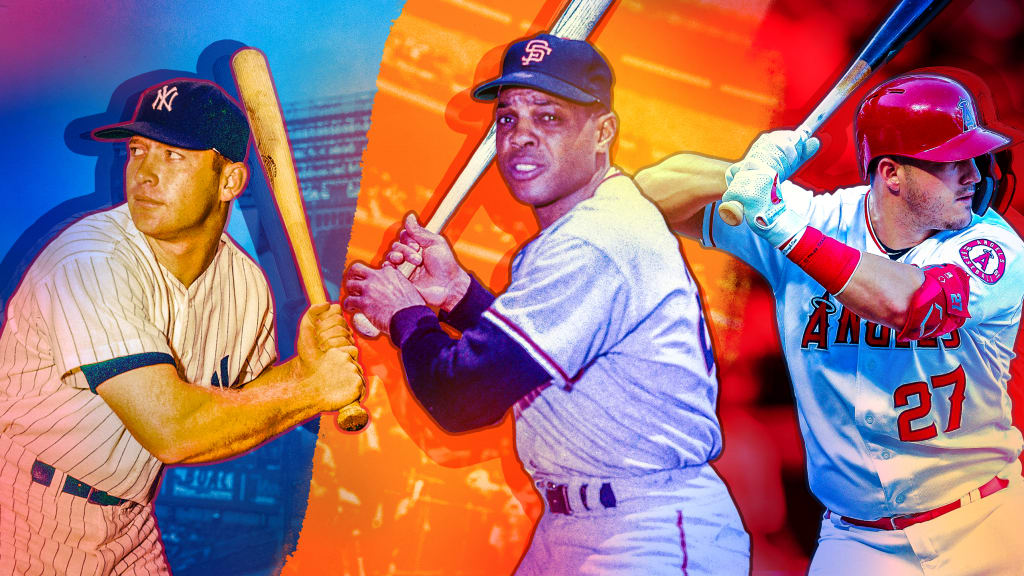
Mickey Mantle. Willie Mays. Who was the better player? Wait a minute, what about another center fielder whose career is still unfolding and so far has him on a trajectory to be one of the greatest players of all-time? We’re referring to Mike Trout, of course.
How can you possibly choose one from this trio?
With the Dream Bracket going on, there is a lot of talk about some of the game’s all-time greats, so what better time to bring back one of baseball’s great debates?
Let’s analyze this trifecta of center fielders and see just how difficult such a choice would be.
First of all -- and let’s just get this out of the way now -- there is no perfect method for determining the value of a baseball player, let alone three of the best to ever take the field. But we’ll give the comparison a shot here and let you make up your own mind.
First, a look at all three individually.
Mickey Mantle
Oh, what could’ve been. Mantle is remembered for being one of the best to ever play the game, but all of his accomplishments came with a pair of bad knees and a host of other ailments that kept him from perhaps becoming the greatest player in baseball history.
First, the numbers: Over an incredible 18-year career with the Yankees, Mantle hit .298/.421/.557 with 536 home runs. He was named American League MVP three times, won the Triple Crown in 1956, batting .353 with 52 home runs and 130 RBIs (not to mention leading the Majors with 132 runs scored, a .705 slugging percentage and a 1.169 OPS), and hit a record 18 World Series home runs.
Now, the legend: There is perhaps no other player in baseball history who has been more mythologized than Mantle, and for good reason. At the time he made his Major League debut on April 17, 1951, the 19-year-old from Commerce, Okla., might have been the strongest and fastest player in the game. His musclebound frame and natural ability made him the hero of an untold legion of baseball fans, young and old. But that was only the beginning.
Two years to the day after he made his MLB debut, Mantle hit a baseball that has been shrouded in lore and spoken of reverently ever since. It came at Washington’s Griffith Stadium, where he smashed a homer that some have estimated traveled 565 feet. Ten years later, Mantle launched a home run that hit the right-field facade above the upper deck at Yankee Stadium, just feet from the roof of the ballpark, leaving players and fans stunned.
Whatever the distances of those mammoth blasts, Mantle’s legend was assured. It would take quite a player to ever exceed what he did at his peak.
Willie Mays
Ted Williams said Mays was “born to play baseball.” The Giants’ center fielder was, indeed, as good as they come. In a 22-year MLB career, the “Say Hey Kid” hit .302/.384/.557 with 3,283 hits, 660 home runs (fifth all-time) and 338 steals. He was the 1951 National League Rookie of the Year, a two-time NL MVP, a 12-time Gold Glove Award winner, and finished in the top five in NL MVP voting seven times.
Mays’ most famous moment came in Game 1 of the 1954 World Series, in which he made “The Catch,” a tremendous over-the-shoulder grab of a drive hit by the Indians’ Vic Wertz at the Polo Grounds. The ball traveled around 460 feet in the oblong park, and after Mays made the stunning catch, he wheeled around and rifled a throw back to the infield to prevent a run from scoring.
Mays led the Majors in homers three times, belting 51 as a 24-year-old in 1955, 49 in '62, and 52 in '65. He also led baseball in stolen bases each year from 1956-58. At age 40 in '71, he led the NL with 112 walks and a .425 on-base percentage.
Many consider Mays to be the greatest all-around player in baseball history.
Mike Trout
He’s not only the best player in the game today, but his statistics, ability and even his physical build are uncannily reminiscent of Mantle. In nine seasons so far, Trout has slashed .305/.419/.581 with 285 home runs and 200 steals. He’s a three-time AL MVP and has finished runner-up in AL MVP voting four times.
Compare that with Mantle’s record through his first nine seasons: .311/.425/.569 with 280 home runs and 98 steals. Given Mantle’s knee problems, the difference in stolen bases is understandable.
And we probably still haven’t seen Trout’s peak. Injuries limited him to 114, 140 and 134 games over the past three seasons, and he’s still only 28 years old. There’s no telling what we might see from him in his second decade in the Majors.
Who’s the best?
There are a number of ways you could dissect the numbers, and the word “best” is subjective. But we’ll focus on two stats here through each player's age-27 season, where Trout is now -- Baseball Reference wins above replacement per 162 games and adjusted on-base plus slugging percentage (OPS+).
WAR will give us an idea of all-around value that can be compared across leagues and eras, and OPS+ will give us offensive values that do the same.
Since individual awards and postseason success depend heavily on factors outside a single player’s control -- the competition, the quality of the team around him, etc. -- that won’t factor into the analysis here. But we have included some notable achievements to help you further appreciate each player’s greatness.
So let’s get into it.
Mantle through age-27 season:
WAR/162: 8.8
OPS+: 173
Accolades: 2-time AL MVP, 1956 Triple Crown, 8-time All-Star, 5-time World Series champion
Mays through age-27 season:
WAR/162: 9.1
OPS+: 158
Accolades: 1951 NL Rookie of the Year, 1954 NL MVP, 2-time Gold Glove Award winner, five-time All-Star, 1954 NL batting title, 1954 World Series champion
Trout through age-27 season:
WAR/162: 9.8
OPS+: 176
Accolades: 2012 AL Rookie of the Year, 3-time AL MVP, 8-time All-Star, 2-time All-Star Game MVP
Well, clearly by these criteria, it’s Trout all the way, right? Not so fast.
First, a separation of one win per season from Trout to Mantle, with Mays between them, is relatively small -- each of these three is producing at a superstar level through age 27. Given that WAR is not the be-all, end-all stat, that's important to keep in mind.
And then there’s the fact that Mays actually got better as he reached his early-30's -- from 1962-65 (age 31 through 34), Mays' WAR/162 was an otherworldly 11.1, and his OPS+ was 174.
An important point in Mantle's favor, which neither Mays nor Trout have, is that he was a switch-hitter. Of the three, Mantle is also disadvantaged due to injury. Particularly on defense, his knees likely prevented him from accruing more value in that department. Then again, baseball games aren’t won or lost based on “what if’s.”
So there you have it. You get one center fielder for your all-time club -- Mantle, Mays or Trout.
Who’s it going to be?



